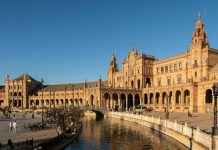Lucban San Isidro Pahiyas Festival
Are you on the lookout for a colourful and festive event to attend within the Philippines? Look no further than the Pahiyas Festival. Held annually on May fifteenth within the town of Lucban, Quezon, this harvest festival is a celebration of gratitude for a bountiful harvest and the patron saint of farmers, San Isidro Labrador.

The history of the Pahiyas Festival dates back to the sixteenth century when the Spanish colonizers introduced Christianity to the Philippines. The festival’s name comes from the word “hiyas,” which suggests “decor” or “ornament.” Through the festival, the townsfolk adorn their houses with fruits, vegetables, and colourful kiping, which is a leaf-shaped wafer manufactured from rice and dyed with food coloring. The decorations are a way of thanking God for the abundance of the harvest and asking for blessings for the approaching 12 months.
Historical Background
The Pahiyas Festival is an annual celebration of thanksgiving after a bountiful harvest. It’s probably the most colourful and vibrant festivals within the Philippines, celebrated every May fifteenth within the town of Lucban, Quezon. The festival’s name is derived from the word “payas,” which suggests decoration or to brighten.
The festival’s origins date back to the sixteenth century when the Spanish colonizers brought Christianity to the Philippines. The locals of Lucban, Quezon were predominantly farmers, they usually celebrated the feast day of San Isidro Labrador, the patron saint of farmers. They’d decorate their homes with fruits, vegetables, and coloured rice wafers called “kiping” to honor the saint.
Over time, the festival evolved into a colourful and vibrant celebration of the town’s agricultural heritage. The locals would compete with one another to create essentially the most elaborate and inventive decorations for his or her homes. Today, the festival attracts hundreds of holiday makers from all around the world who come to witness the colourful and vibrant celebration of the town’s cultural heritage.
In 2013, the Pahiyas Festival was declared as a National Cultural Treasure by the National Commission for Culture and the Arts, recognizing its cultural significance and contribution to the country’s cultural heritage.
The Pahiyas Festival just isn’t only a celebration of the town’s agricultural heritage but additionally a celebration of its people’s resilience and creativity. The festival has change into a crucial cultural event within the Philippines and a testament to the country’s wealthy cultural heritage.

Significance of Pahiyas Festival
The Pahiyas Festival is a crucial cultural event within the Philippines that takes place every May fifteenth. The festival is well known in honor of San Isidro Labrador, the patron saint of farmers. It’s a thanksgiving celebration for a bountiful harvest and can be a approach to pay tribute to the farmers who work hard to offer food for the community.
The festival is especially significant within the town of Lucban, Quezon, where it originated. The town is thought for its colourful decorations manufactured from kiping, a leaf-shaped wafer manufactured from rice and dyed with food coloring. The kiping is used to brighten houses, streets, and public spaces, making a vibrant and festive atmosphere.
The festival has an extended history that dates back to the sixteenth century. It was originally a pagan festival that was transformed right into a Catholic celebration when the Spanish colonizers arrived within the Philippines. The festival has since evolved into the colourful and grand event that it’s today.
The Pahiyas Festival just isn’t only a celebration of the harvest but additionally a celebration of the community. It brings people together to share food, music, and dance. It’s a time to reconnect with old friends and make latest ones. The festival also allows local businesses to showcase their services, attracting visitors from all around the Philippines and beyond.
In summary, the Pahiyas Festival is a major cultural event within the Philippines that celebrates the harvest, pays tribute to farmers, and brings communities together. It’s a colourful and vibrant celebration showcasing the Philippines’ wealthy culture and traditions.
Cultural Elements
The Pahiyas Festival is a celebration of the wealthy culture and heritage of Lucban in Quezon Province. The festival is a testament to the strong connection between the local people and their agricultural roots. On this section, we’ll explore the varied cultural elements of the Pahiyas Festival.
Artistic Elements
One of the crucial striking elements of the Pahiyas Festival is the colourful and complex decorations that adorn the homes and streets of Lucban. The decorations are made using quite a lot of materials, including rice grains, vegetables, fruits, and flowers. Probably the most famous decoration is the kiping, a colourful leaf-shaped wafer created from rice flour and food coloring. The kiping is used to create elaborate designs covering the homes’ partitions and roofs.
Along with the kiping, other artistic elements akin to paintings, sculptures, and handicrafts are also on display in the course of the festival. These artworks showcase the talent and creativity of the local artists and craftsmen.
Food and Cuisine
Food plays a major role within the Pahiyas Festival. Local delicacies akin to pancit habhab, longganisa, and lucban quezo are served in abundance in the course of the festival. Visitors also can enjoy street food akin to grilled corn, fish balls, and barbecued meat.

Certainly one of the highlights of the festival is the “Kamayan sa Palaisdaan” or “eating together with your hands by the fishpond.” This unique dining experience involves eating a feast of grilled fish, shrimp, and other seafood using only your hands.
Music and Dance
Music and dance are an integral a part of the Pahiyas Festival. Traditional Filipino music akin to kundiman, harana, and rondalla, might be heard throughout the festival.
Festival Activities
The Pahiyas Festival is a colourful and vibrant celebration that takes place within the town of Lucban every May fifteenth. The festival is a celebration of the town’s bountiful harvest and pays homage to San Isidro Labrador, the patron saint of farmers. Listed below are a number of the festival activities which you can expect to see in the course of the celebration:
Parade
Certainly one of the highlights of the Pahiyas Festival is the grand parade. The parade features colourful floats, marching bands, traditional costumes, and street performers. The parade starts early within the morning and winds its way through the town’s streets, providing a energetic and festive atmosphere.
Decorating Contest
One other popular activity in the course of the Pahiyas Festival is the decorating contest. The competition encourages residents to brighten their homes with colourful and inventive decorations created from fruits, vegetables, and kiping (coloured rice wafers). The homes are judged based on creativity, originality, and overall appearance. The competition winners receive money prizes and bragging rights for the 12 months.
Agricultural Showcase
The Pahiyas Festival also allows farmers to showcase their agricultural products. The festival features an agricultural showcase where farmers display their crops and produce. Visitors can see a wide range of fruits, vegetables, and other agricultural products grown within the region. The showcase is a fantastic approach to find out about local agriculture and to support local farmers.
Impact on Tourism
The Pahiyas Festival is one among the Philippines’ hottest and colourful harvest festivals. It attracts hundreds of tourists from all around the world every 12 months. The festival is held every May fifteenth within the town of Lucban, Quezon Province.
The festival has a major impact on the tourism industry within the Philippines. It has helped to advertise cultural tourism within the country and has change into a serious tourist attraction. The festival has also helped to spice up the local economy in Lucban, as many businesses profit from the increased tourism in the course of the festival.
Certainly one of the explanation why the Pahiyas Festival is so popular amongst tourists is due to its unique and colourful decorations. The festival is thought for its vibrant decorations created from kiping, a standard rice wafer, and other local produce. Tourists come to see the colourful houses and streets adorned with these decorations, which make for excellent photo opportunities.
The Pahiyas Festival has also helped to preserve and promote the local culture of Lucban. The festival is deeply rooted within the town’s history and traditions and celebrates the bountiful harvest of the town’s farmers. By participating within the festival, tourists experience the local culture and traditions of Lucban, which helps promote cultural exchange and understanding.
Overall, the Pahiyas Festival has positively impacted tourism within the Philippines. It has helped to advertise cultural tourism, boost the local economy, and preserve and promote the local culture of Lucban.

Regularly Asked Questions
What are the standard foods served during Pahiyas Festival?
Pahiyas Festival is a celebration of the harvest season, and as such, traditional Filipino dishes created from fresh produce are commonly served in the course of the festival. Some popular dishes include pancit habhab, longganisa, and kesong puti. Visitors also can take pleasure in local delicacies like suman, bibingka, and kakanin.
Where is Pahiyas Festival celebrated within the Philippines?
Pahiyas Festival is primarily celebrated within the town of Lucban, Quezon, Philippines, where it originated. Nevertheless, the festivities may also be present in other towns in Quezon Province, akin to Tayabas, Gumaca, and Sariaya.
What are the common activities during Pahiyas Festival?
During Pahiyas Festival, visitors can expect a wide selection of activities, including street parades, cultural shows, and art exhibits. Various competitions are held, akin to the “Kiping” and “Anok” competitions, where locals compete to create essentially the most creative and colourful decorations created from rice wafers and vegetables.
What are the standard costumes worn during Pahiyas Festival?
The standard costumes worn during Pahiyas Festival are inspired by the farming lifestyle of the locals. Men typically wear “barong Tagalog,” a standard formal wear created from pineapple fibers, while women wear “balintawak,” a loose dress created from lightweight fabric. Farmers also wear “salakot,” a wide-brimmed hat created from woven bamboo.
What’s the theme of Pahiyas Festival?
The theme of Pahiyas Festival is to have fun the bountiful harvest season and to honor San Isidro Labrador, the patron saint of farmers. The festival is a way for locals to precise their gratitude for his or her blessings and showcase their creativity and cultural heritage.
Who’s the patron saint of the Pahiyas Festival?
San Isidro Labrador is the patron saint of the Pahiyas Festival. He’s believed to have miraculous powers that may bring good harvests to farmers and protect them from natural disasters. Locals pay tribute to him by decorating their homes with colourful rice wafers, fruits, and vegetables in the course of the festival.
Follow the in case you want more travel and food-related updates.
Read: Top 15 Best Things to Do in Quezon + Tourist Spots & Places to Visit
Unlock the world’s wonders with unforgettable journeys tailored just for you! Whether you crave sun-kissed beaches, thrilling adventures, or rich cultural escapes, your dream destination awaits. Enjoy seamless travel with expert tips, exclusive deals, and handpicked experiences that Turn Every Trip into a lifetime memory.









